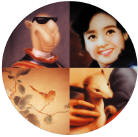 |
"Tonic+"--solo show by Zhou Tiehai
ShanghART H-Space October 30 - November 12,2004 |
|
|
|
|
|
|
|
|
|
|
|
|
|
|
|
|
|
|
|
|
|
|
|
|
|
|
|
|
|
|
||
|
|
|
|
|
|
|
|
|
|
|
|
|
|
|
|
|
|
|
|
|
|
|
|
|
|
||
Text On the Exhibition:
|
ShanghART Gallery will run an
exhibition featuring works by Zhou Tiehai from October 30
to November 27 at
two different venues. One is at the gallery near Park 97, and the other is
the new warehouse exhibition venue along the Suzhou Creek.
It is not easy to describe Zhou’s artworks in several words. Unlike his peers who faithfully follow their own exclusive symbols or landmarks, Zhou’s symbols varied, ranging from his camel series to fake cover series. Zhou ought to have stepped on a easy path if he follows these successful landmarks, but he did not. Like his profound personality, his works always bring a surprise to the public. Honestly speaking, there is no close link among those different themed renderings, which proves that he is active in exploring Chinese culture and spirit from totally different angles. Like his “Female Movie Stars of the 1980s”, the beautiful faces are reminiscent of a systematized society, but on close inspection, viewers will find an earnest expectation of the future from their eyes. Zhou’s works are never exaggerated or overwhelmingly dominant. He didn’t state his position in his artworks, but the viewers are unwittingly be dragged back to those bygone days. Zhou’s recent ink-wash series applied the advanced printing technique in depicting the masterpieces of traditional Chinese paintings. Traditional Chinese paintings are not easy to maintain in good condition due to the fragility of the rice-paper and the oxidation of ink and splash. But Zhou’s contemporary way of recreating these masterpieces secured the “tradition” fused with new meanings.
周铁海画展 在中国当代艺术界内,周铁海的作品是很难用一两句话来概括的. 他不像其他一些艺术家有其专属的标记或特定的符号.他蛮可以沿着一条更轻松的路子走下去,因为不管他的"骆驼系列"或是"假杂志封面"早已在中国当代艺术的舞台上建立了自己的地位。延续一个符号自然比新创一个符号容易得多.这次在香格纳画廊举办的周铁海个展集中了他的一些早期,中期和近期的作品.展地除了在复兴公园内的香格纳画廊,还被安排在刚刚启用的苏州河旁仓库展馆——香格纳H空间.为期一个月的展览充分表现了周铁海这位具有国际影响力的中国当代艺术家丰富的创作. 周铁海独创的喷绘技法在"八十年代明星系列"和"国画系列"中,更是得到了淋漓尽致地发挥.这位沉着的艺术家从未停止过他从不同角度对艺术的思考.那些有着美好青春脸庞带着八十年代丰富表情的女明星,淳朴清澈的眼神,掩饰不住对未来生活的幻想和欣喜.观众被作品拉回到了那个逝去的年代,引起人们对逝去青春的反思. 周铁海是个跳跃性思维的艺术家,他的“国画系列”是当代艺术作品中颇具审美感的作品.这些大幅的作品依赖现代喷绘手法复制了中国古代水墨画中的精品.古代的水墨画向来不易保存,因其宣纸的材质和水墨的氧化,而周铁海的作品"固定"了它们.以当代手法固定传统继而赋予传统新的涵义.
Stars of the 80s Going through these rich fossil-like facial expressions of the 80s is like watching humanity’s adolescence period in which un-concealable joy and fantasy, simplicity and naivety, bestiality and spirituality intermingle among each other. What horrifying expressions! I used to linger over here. Get them onto the guillotine. Contemporary art is this merciless sword! If the water is clear then it must be innocent; the water originally clear so it will be clarified ultimately. Cut off the bestial joy of fantasies of modern civilization. Keep the freedom that no one can take away. The devil fails to find your trace… Look at your own facial expression now: truly phantomlike looks; what else will you metamorphose to? Placebo A placebo is not a medication designed to cure a particular disease; it is just an attempt to give people some psychological comfort. These works have the following distinct characteristics: 1. Western culture, which represents the main advance of human civilization, adopts a pharmaceutical way of treating the human condition. To use a Chinese phrase this is ‘treating the branches while neglecting the root’, and ultimately can only be a kind of self-consolation or self-intoxication. 2. The works themselves are an attempt to interpret Western standards. When it is incorporated by mainstream culture, non-mainstream culture reluctantly accepts its inability to break free of the standard view, just like someone awaking from a dream, and it unavoidably becomes a foil for global culture. 3. This phenomenon is of symbolic significance in East-West cultural exchange. On one hand, these works are full of admiration for the achievements of Western culture, and try to use Western medicine to cure Eastern ills. On the other hand, they are well aware that this medicine has side effects, and is unable to effect a radical cure, but people will give any doctor’s prescription a try when their illness is severe. Herein lies the powerlessness and suffering of the artist. Tonic Tonic here has a neutral character; it is by no means absolutely a good thing, and is a narcotic when used inappropriately. These works magnify Chinese and Oriental culture to the point of vertigo: 1. They are not directed at any disease of the human spirit, nor do they aim to specifically cure an affected part; rather they express ‘the unity of heaven and man’, the Chinese medical philosophy of cultivating one’s moral and physical nature. Tonics are one type of medicine used for this purpose, and are directed at the whole person, at mobilizing the innate vital energies. Here, illness is not necessarily a bad thing. 2. The Misty effect of these large canvases originates from the idea of the Will of Heaven. Because of this the impression they give people is non-specific and indirect. Oriental-style, they move and influence people in an invisible way. This is the paradise imagined by Chinese religion, full of tranquility and depth, free from brightness and gaudiness. 3. These works are the refraction of a sense of scholarly seriousness in my spirit. Obviously, they are a ‘tonic’, but constantly vacillating, afraid of using too much, of becoming addicted to it just like ‘Placebo’. After all these are the work of ancient masters, and if they are the work of ancient masters then they are medications; if they are medications then, strictly speaking, be they ‘placebo’ or ‘tonic’, in either case it is not a particularly good thing. |